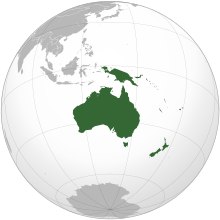Geography/Oceania
Oceania includes Australia and various islands scattered around the Pacific, most of them northeast of Australia and southwest of Hawaii.

Australia
editAustralia is the smallest of the continents, but it is still large. Of all the continents, Australia has the smallest difference between the highest and lowest points; its highest peak is the lowest-lying of all the high points of continents (see Wikivoyage: Seven Summits). The highest point stands well under 10,000 feet (3,000 m), so even at its highest, the mountains in Australia are more like the Appalachians in height than the Rockies, Himalayas, or Andes.
In general, Australia is not a mountainous continent. The "Great Dividing Range", as Australia's main mountain range is called, is not comparable to other great dividing ranges like the Rockies or the Sierra Nevada. However, for Australia, the Great Dividing Range is a very important mountain range that divides the relatively small eastern region from the west. This eastern region, and the region within the mountains, has a relatively high population compared to what exists west of the Great Dividing Range. Much of the geographical core of Australia, especially toward the south, is dry. The main "lake" in this region of Australia, Lake Eyre, is not really a lake at all. Instead it is a low-lying (below sea level), dry region of the continent that occasionally receives some rainfall; as a result of this rainfall, the lowest parts of the basin fill with water temporarily, until evaporation removes the water. Much of Australia consists of flat terrain, which is referred to as "the Outback".[1] However, not all of Australia west of the Great Dividing Range is flat; for example, Uluru (also called Ayers' Rock) exists far from the coastline, but is an outstanding geographical feature that certainly marks a shift in terrain.
The Australian continent is entirely within the Southern Hemisphere, unlike Africa and South America, although the northern tips of Australia are fairly close to the equator. These northern regions are tropical due to their proximity to the equator and the lush tropical islands to the north.
There are some rivers and creeks in Australia; notable ones that cross substantial portions of the continent include the Murray River, the Darling River, and Cooper Creek. However, there are quite a few short, tropical rivers in the north, especially the far north, of the continent.
Islands of Oceania
editOceania, however, includes many islands along with the continent Australia. These vary from the large North and South Islands of New Zealand to tropical island-nations including Fiji, Samoa, Vanuatu, and even the Pitcairn Islands.
The two main islands of New Zealand—the North Island and the South Island—and the various smaller islands that surround them are a few examples of the numerous islands in the Pacific Ocean. The highest point in New Zealand is on the southern side, is Mt. Cook, and has an elevation above 10,000 feet (3,000 m). New Zealand also possesses a couple smaller (but still quite large) island groups that are remote by comparison. Among these are the Chatham Islands and the Auckland Islands; the latter group, the Auckland Islands, includes two main islands, Auckland Island and Adams Island.[2] These islands are substantial in size, but as of 2019 are uninhabited.
There are many other islands in Oceania: among these is the large island of New Guinea, which is home to mountains even larger than Mt. Cook, and some groups of much smaller islands. These smaller islands are scattered across the Pacific, reaching west as far as the Solomon Islands and reaching as far east as Easter Island. (Easter Island is actually so far east that it is part of Chile, a South American country.) The Pitcairn Islands, famous for the unusual history of their inhabitants, exist within this region. The eastern islands of Oceania, such as those of French Polynesia, are smaller than the islands to the west, such as those of New Zealand, New Guinea, and the Solomon Islands.
Although it is not a land feature, the Challenger Deep is an important feature in the Pacific Ocean. It is near the Northern Mariana Islands and is the deepest point in any ocean in the world. It's in the Marianas Trench, which is in the vicinity of Guam, a famous island in the Pacific.
Hawaiian Islands
editThe Hawaiian Islands do not fit easily into a category, but in this course they're placed in Oceania. The islands are volcanic, and among the volcanoes in the island group are Mauna Loa and Mauna Kea; these peaks are both between 10,000 feet (3,000 m) and 15,000 feet (4,600 m). Notable islands in the group include the island that's actually called Hawaii, the largest of the islands; Maui; Oahu; and Kauai. The big island, Hawaii, is triangular in shape.
Quiz
editComplete the Oceania quiz.
See also
editReferences
edit- ↑ "The bush". Wikipedia. 2019-02-16. https://en.wikipedia.org/w/index.php?title=The_bush&oldid=883582208.
- ↑ "Auckland Islands". Wikipedia. 2019-04-02. https://en.wikipedia.org/w/index.php?title=Auckland_Islands&oldid=890683710.